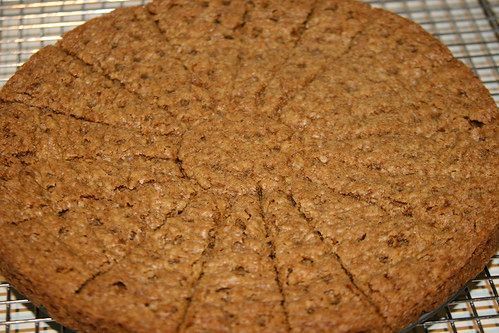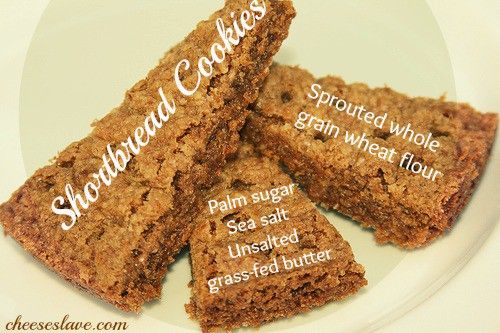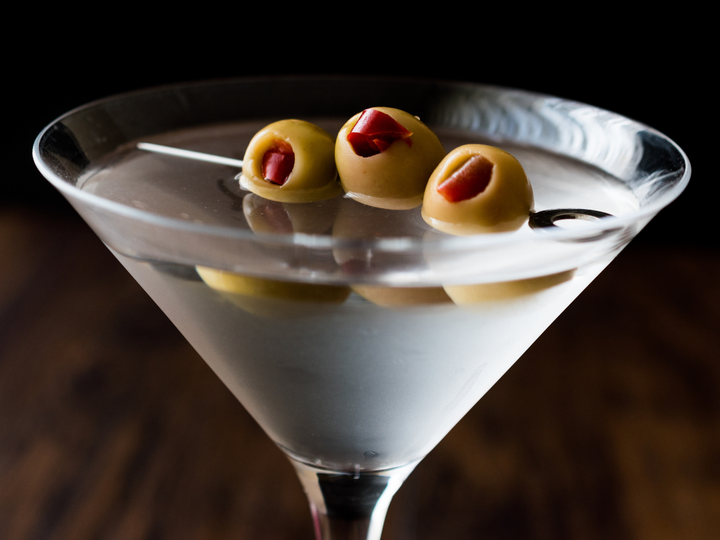Sprouted Flour Shortbread Cookies with Grass-fed Butter
In this recipe, I show you how to make shortbread cookies made healthier with sprouted flour and grass-fed butter.

In this recipe, I show you how to make shortbread cookies made healthier with sprouted flour and grass-fed butter.
Why I Love These Cookies
All my life, I have loved shortbread cookies. I usually buy Walker brand, from Scotland, which are, thankfully, still made with real butter. I love the sandy texture, the sweet taste.
But most of all, I love the butter. Butter is not only delicious, it’s also very good for you.
Someone once told me I should change the name of this blog from CHEESESLAVE to BUTTERSLAVE. It’s a tough call. I love them both.

Got Vitamin K2?
Grass-fed butter is one of the very best sources of vitamin K2, which most of us need desperately. Especially kids and the elderly. Did you know that vitamin K2 is critical for building bones and teeth?
Without vitamin K2, your body can’t properly deposit calcium in the right places. Vitamin K2 is what helps put calcium into the bones and teeth. When don’t get enough vitamin K2 in our diet, the calcium we ingest gets put into fatty tissue and organs — including the brain, heart and kidneys.
Ever wonder why so many people get osteoporosis as they age? Why broken hips are so common among the elderly? And why so many of our elderly suffer from strokes (which can be caused by calcium deposits in the brain), heart disease (calcium deposits in the arteries), and kidney stones (calcium deposits in the kidneys)?
See a pattern here? What we mistakenly thought was cholesterol deposits in the brain and arteries is actually calcium.
The solution? Eat more butter! (Don’t you just love it when butter is the solution?)
Why Grass-Fed Butter?
Of course, it must be grass-fed butter. That means butter made from cream from cows on pasture. Vitamin K2 is produced in the digestive systems of cattle eating grass. Grass contains vitamin K1, which is converted to K2. If you feed a cow corn or soybeans, it will not create vitamin K2.
I believe this is why so many American children today suffer from cavities and crooked teeth (I think we’re at 90%), and why heart disease and stroke are some of America’s top killers. In the past few decades, all of our cows were moved from pasture to factory farms. As a result, the milk and cream they produce is woefully inadequate when it comes to nutritional quality.
On top of that, butter has been villainized by industrial food. Why? Because they want to sell margarine, Crisco and other synthetic, highly processed fats and oils. Of course they don’t want us enjoying rich, creamy butter from our neighbor’s cow! Where’s the profit for them in that? If they make you think butter is bad for you, you’ll eat their crappy margarine.
Give someone you love something sweet and good for their health: sprouted flour shortbread cookies. These cookies are loaded with butter — almost a full tablespoon in every cookie. And this butter is chock-full of vitamin K2.
Notes on this Recipe
I modified this recipe from one that I found in Cook’s Illustrated. I love Cook’s Illustrated because the recipes are tested and retested — and they always come out great. I’ve never had one fail.
I’ve modified the recipe in a few ways. To boost the nutrition and make the cookies more digestible, I used sprouted flour instead of white flour. I used natural, unrefined sweeteners instead of refined sugar. I also used real sea salt instead of table salt, and grass-fed butter. If you don’t know of a local farmer producing grass-fed butter near you, you can find it online or use Kerrygold Irish grass-fed butter, available in many supermarkets including Trader Joe’s.
I also changed the method somewhat. I didn’t mean to do it — it was an accident. But it worked pretty well.
Also, I haven’t tried making these cookies with sucanat. The slightly more refined palm sugar and maple sugar worked very well. Next time I might do all palm sugar, since the maple sugar is a bit “mapley”. Very good, but mapley.
Also, I forgot to reserve 1 TBS of sugar for sprinkling on top at the end (as specified in the original recipe). The cookies really don’t need it, but if you want to, go for it.
I’ll experiment more with the recipe (I am actually making more cookies today — they go fast!) but for now, this one will do you proud.

Sprouted Flour Shortbread Cookies
Makes 16 wedge cookies — 17 if you count the round one. You might want to double or triple this recipe — trust me, you will want to make more.
Ingredients:
Sprouted whole grain wheat or spelt flour (2 cups)
Sugar, palm sugar and/or maple sugar (2/3 cups)
Sea salt (1/4 teaspoon)
Unsalted grass-fed butter, unsalted, cold (8 ounces)
Equipment:
Springform cake pan (9-inch)
Bamboo skewer or other pointy thing (I used the pointy end of a beater from an electric mixer)
2-inch biscuit cutter (you could also use a small juice glass)
Optional: Parchment paper
Optional: Standing mixer (really not necessary; I used my hands)
Directions:
1. Set oven rack to middle. Preheat oven to 425 degrees.
2. Cut a round of parchment paper to fit in a 9-inch springform cake pan (optional — do this if you want to avoid the toxic non-stick lining of most springform pans). Set aside.
3. Add flour, all but 1 tablespoon sugar (reserve for sprinkling), and salt to mixing bowl. Mix at low speed until combined (or use your hands or a wooden spoon to blend).
4. Cut very cold butter into 1/2-inch cubes.
5. Add cutter cubes to flour mixture. Mix on low speed (or use your fingers to blend together) until the dough looks like wet crumbs. All the butter should be mixed in thoroughly.
6. Press crumbly dough into springform pan. Use your fingers, and then the bottom of a glass to press down on the surface and make it smooth and level.
7. Reduce oven temperature to 300 degrees and place shortbread in oven.
8. Bake 20 minutes.
9. Remove pan from oven. Set on a cutting board. Let cool for 5 minutes.
10. Remove the top part of the springform pan and leave the shortbread sitting on the bottom piece.
11. Set the 2-inch biscuit cutter in the center of the shortbread. Press down hard. Pull up, leaving the center circular piece intact.
12. Using a sharp knife, cut the outer ring into 16 equally sized wedges.
13. Using a skewer or other pointy-tipped implement, poke holes in the top in a decorative pattern.
14. Return shortbread to oven and continue to bake until golden, about 40 minutes longer. You may want to put an extra cookie sheet underneath to catch the butter dripping (it dripped for me).
15. Remove from oven and sprinkle shortbread evenly with reserved 1 tablespoon sugar. Let cool for at least 15 minutes.
16. Cut at scored marks into wedges. Let cool for at least an hour.
Store shortbread cookies in an airtight container for up to 7 days. (Of course they will never last that long)



Comments ()